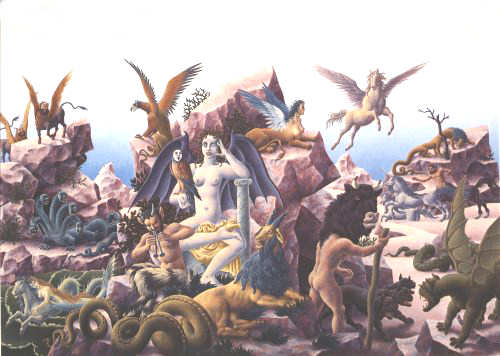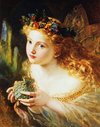Monstropedia is the ultimate online encyclopedia of monsters in myth, magick and legend. |
Want to add more? Become an editor. |
 |
||||||||
|
|
|
Other ways to browse Monstropedia | ||||||
|
|
|
|||||||
| Welcome to Monstropedia, the original open-source bestiary!
The mission of Monstropedia is to create the ultimate online media library about monsters, gathering information and documents from the earliest myths onwards to the present day, developing a coherent set of methods to analyse each creature and attaching current theories about their existence. mon·ster n. 1. a. A creature, usually legendary or imaginary, such as a centaur or harpy, that combines parts from various animal or human forms. 1. b. A creature having a strange or frightening appearance. 2. An animal, plant, or other organism having structural defects or deformities. 3. A very large animal 4. One who inspires horror or disgust. This project has just started and there is little content at the moment. Our current records indicate that there are more than 5000 different monsters to be catalogued... so there is work for everybody! Don't be shy, join us and become a part of our community. If you would like to add to the encyclopedia, you are welcome to become an editor, where you will be able to start to create and edit articles. Help add to Monstropedia in two easy steps...1. Become an editor by signing up2. Learn how to edit with the Really Simple Tutorial If you find Monstropedia useful, please consider donating.
FRIENDS OF MONSTROPEDIA
MONSTROPEDIA ANNOUNCEMENTS
|
 Featured Article Featured Article
FairyA fairy (also fairie or faerie) is a spirit or supernatural being that is found in the legends, folklore, and mythology of many different cultures. They are generally humanoid in their appearance and have supernatural abilities such as the ability to fly, cast spells and to influence or foresee the future. Although in modern culture they are often depicted as young, sometimes winged, females of small stature, they originally were of a much different image: tall, angelic beings and short, wizened trolls being some of the commonly mentioned fay. The small, gauzy-winged fairies that are commonly depicted today did not appear until the 1800s. EtymologyThe words fae and faerie came to English from Old French which originated in the Latin word "Fata" which referred to the three mythological personifications of destiny, the Greek Moirae (Roman Parcae, "sparing ones", or Fatae) who were supposed to appear three nights after a child's birth to determine the course of its life. They were usually described as cold, remorseless old crones or hags (in contrast to the modern physical depiction). The Latin word gave modern Italian's fata, Catalan and Portuguese fada and Spanish hada, all of which mean fairy. The Old French fée, had the meaning "enchanter." Thus féerie meant a "state of fée" or "enchantment." Fairies are often depicted enchanting humans, casting illusions to alter their emotions and perceptions so as to make themselves at times alluring, frightening, or invisible. Modern English inherited the two terms "fae" and "fairy," along with all the associations attached to them. A similar word, "fey," has historically meant "doomed to die," mostly in Scotland, which tied in with the original meaning of fate. It has now gained the meaning "touched by otherworldly or magical quality; clairvoyant, supernatural." In modern English, the word seems to be conjoining into "fae" as variant spelling. If "fey" derives from "fata," then the word history of the two words is the same. [1] Strictly, there should be distinctions between the usage of the two words "fae" and "faerie." "Fae" is a noun that refers to the specific group of otherworldly beings with mystical abilities (either the elves (or equivalent) in mythology or their insect-winged, floral descendants in English folklore), while "faerie" is an adjective meaning "of, like, or associated with fays, their otherworldly home, their activities, and their produced goods and effects." Thus, a leprechaun and a ring of mushrooms are both faerie things (a fairy leprechaun and a fairy ring), although in modern usage fairy has come to be used as a noun.
|


